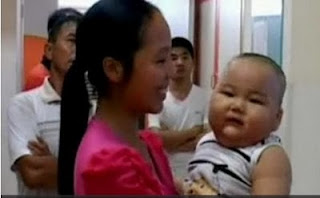I think this article is good to share..especially..new mom!!!
Author Name:Rebecca Glover RN RM IBCLC
L.A.T.CH.O. - Learned Attachment Techniques CHanges Outcomes
Breastfeeding Natural? YES! – Comes Naturally? NO!
For a mother breastfeeding is a learned behaviour, but for her baby, breastfeeding is instinctive.
Natures way for mothers to learn, is by subconsciously observing other mothers holding, positioning, and attaching their babies successfully.
Unfortunately almost every human culture has interfered with this natural process and today many women don’t have the opportunity to learn to breastfeed naturally. Mothers certainly don’t understand how to work with their baby’s innate behaviours, unless someone explains it to them.
Today, health professionals and lay counsellors in this field, play an absolutely crucial role in replacing the loss of the natural process, by teaching mothers attachment techniques that support innate infant behaviour and the “mechanics” of breastfeeding.
The first 3-4months of life is a unique period for the human infant. When feeding behaviour is entirely instinctive and reflex and the infants anatomy is uniquely matched to these behaviours. These reflex behaviours are dependent on; appropriate sensory input, adequate positional stability and the maturity and functionality of the physical structures involved.
When 0 to 3-4 month old infants are provided with the appropriate sensory input, (“skin to skin” or firm contact with the mothers’ body and breast) they instinctively search for the breast by lifting their heads and thrusting the chin and mouth forward, which in turn has the effect of tilting the head backwards. This “Instinctive Position” or posture anatomically matches the processes required for good attachment and the “suck-swallow-breathe” cycles that are breastfeeding.
The Head tilt – extension or flexion
When a baby lifts the chin and mouth towards the breast, this has the effect of tilting the head backwards. The perception that this puts the infant into extension, rather than flexion, has caused a lot of consternation. Lift your own chin and mouth as if searching for the breast and you will experience that your cervical vertebrae stretch forward as your head tilts backwards. When a baby is brought to the breast with their hips and shoulders against mothers’ body, and lift their chin and mouth, to search for the breast, they are simply stretching the cervical spine forward; a very different scenario from extension, when a baby throws its head and shoulders back away from the breast.
To make Good Attachment physically possible babies need to be brought to the breast in the “instinctive position”, where the mouth opens wide, the tongue extends forward and baby can “scoop” a large amount of breast over the tongue and lower jaw.
The nipple rolls back, close to the junction of the hard & soft palate, and the breast fills baby’s mouth, with the tongue & lower jaw positioned deep under the milk ducts and breast tissue immediately behind the nipple. (see Rebecca’s unique graphics) Attachment is not physically possible with the chin down, and try swallowing with your chin dropped towards your chest!
With the essential mouthful in place, (appropriate sensory input – everything touching in baby’s mouth) the infant responds, using the combination of; negative pressure in the pharynx, the mothers milk ejection reflex and the mechanical action of the lower jaw & tongue to comfortably and effectively breastfeed.
The Magic of Positional Stability
The newborn infant is totally reliant on external support, positional stability.
Without a stable base, function and mobility is less controlled or even impossible. Therefore, for the infant to execute the complex oro-motor movements required for attachment and breastfeeding they must be provided with the appropriate stability.
Oral Stability is dependent on neck and shoulder girdle stability, which are inturn, dependant on trunk and pelvic stability.
To support the reflex behaviours for effective Breastfeeding infants require:
Midline Stability – body centrally straight from head to toe The symmetrical movement of the muscles on both sides of baby’s body is crucial for optimal oro-motor function
Shoulder Girdle Stability – firm support in the middle of baby’s body between the shoulders. This stabilises the neck, head, jaw, tongue, pharynx & larynx to enable controlled and effective oro-motor movement.
Trunk and Pelvic Stability – shoulders and hips turned towards and supported against the mothers’ body.
When a mother brings her nought to three to four month old baby to the breast in the “instinctive position” AND provides them with the necessary positional stability it triggers and supports the innate sequence of reflex behaviours that are breastfeeding




![Order Online [ID: 858776]](https://blogger.googleusercontent.com/img/b/R29vZ2xl/AVvXsEjmU-6IbyCW30CVvckO3iYY7VWut27oz-6hOd0hdaGX49WBGLhI6YII8F04BxZBkuA6J3WvxmPzkwM8M6jwvytbtnuLOjv6SOdLKAX4heHMeyBjc4f8rI5-Sn5zbapcvCuPtLe9mfH_qWr8/s1600-r/esell-shaklee-logoa2PNG.png)










